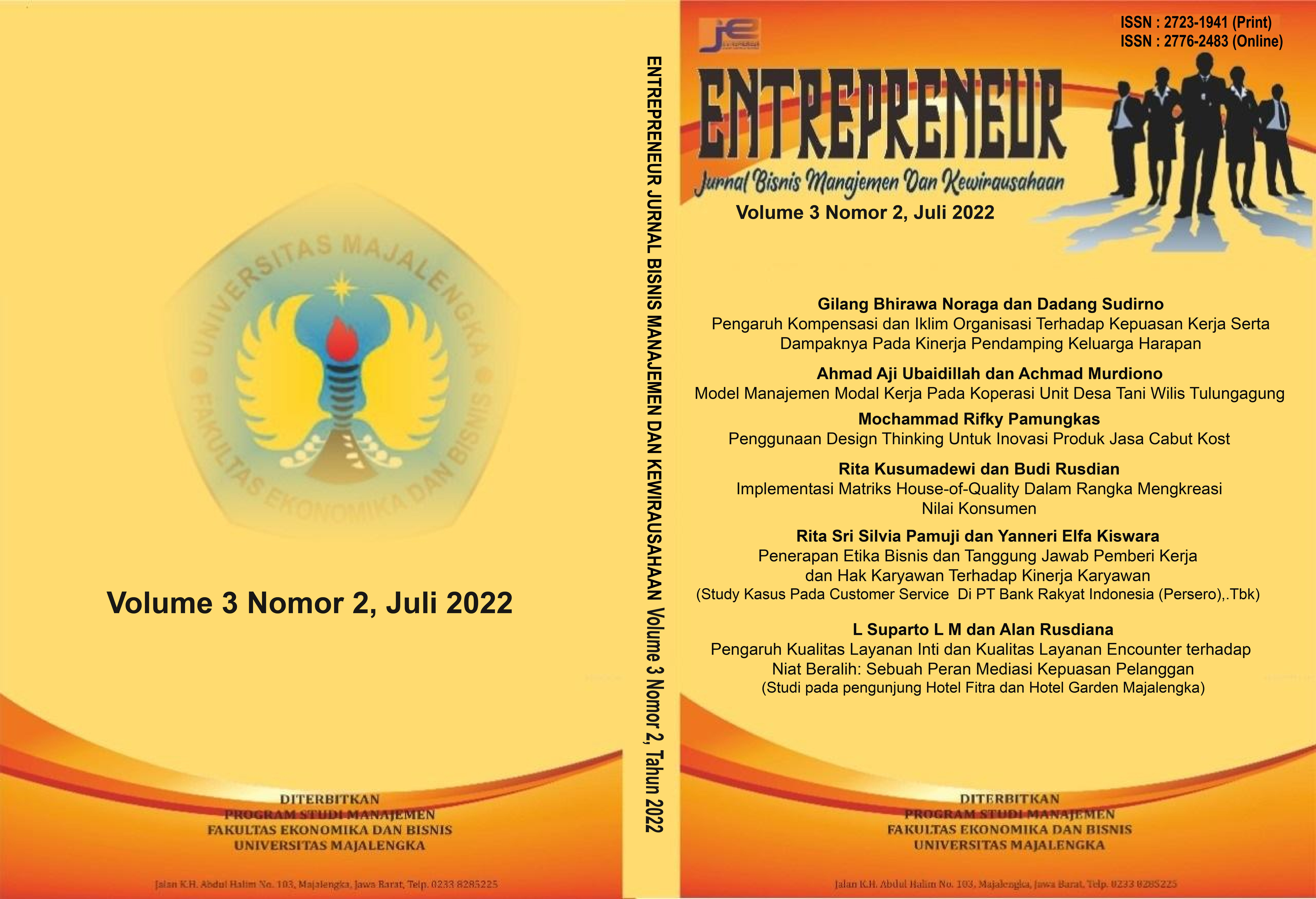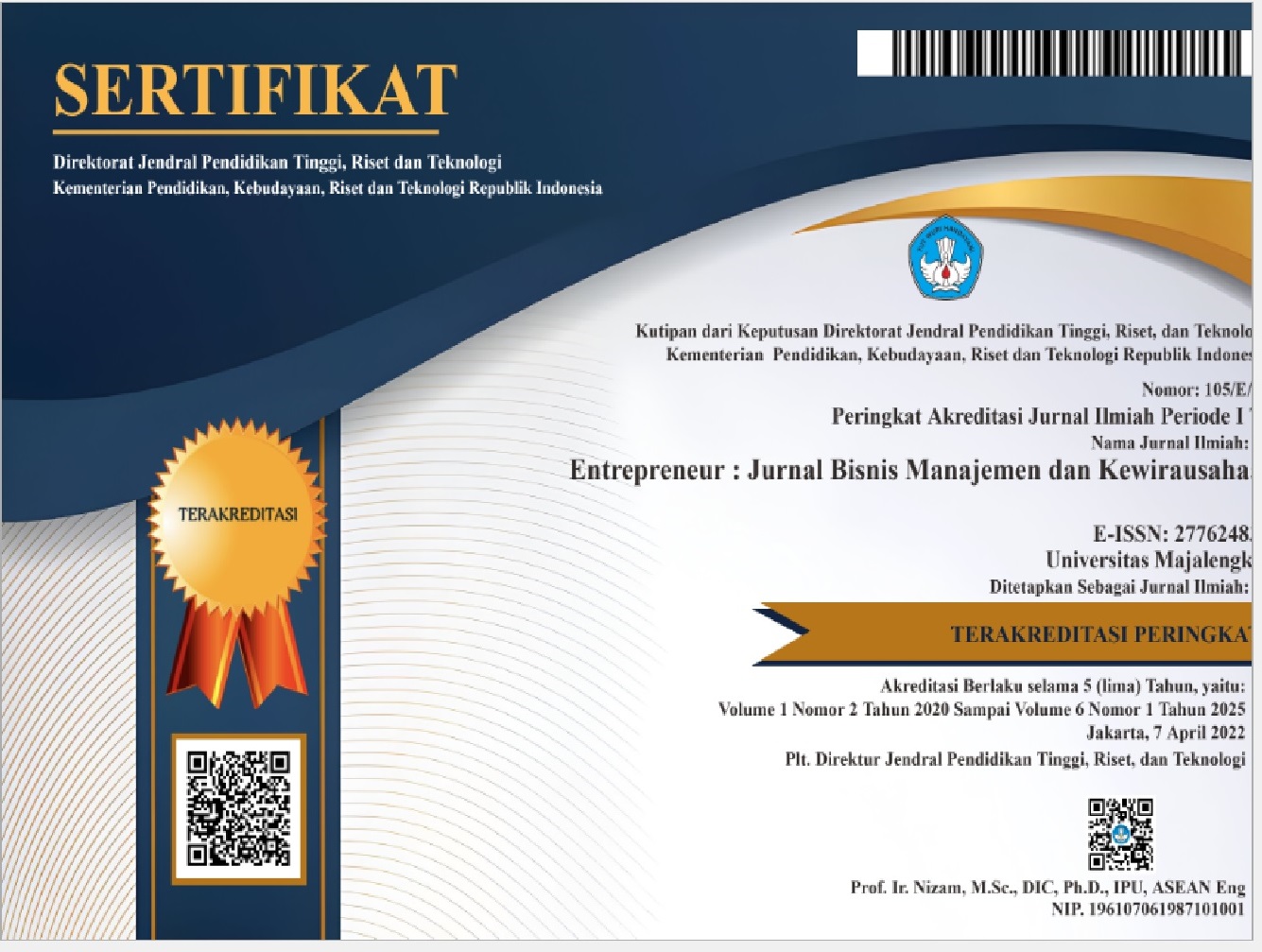Penggunaan Design Thinking Pada Inovasi Produk Jasa Cabut Kost
DOI:
https://doi.org/10.31949/entrepreneur.v3i2.1517Abstrak
Kondisi pandemi Covid-19 di Indonesia hingga saat ini telah berdampak pada seluruh pelaku usaha, oleh karena itu semua pelaku dari berbagai bidang usaha perlu melakukan terobosan atau inovasi agar mampu bersaing dan tetap bertahan. Permasalahannya sekarang adalah semua harus dituntut untuk memberikan pemecahan masalah yang tepat dan mampu diimplementasikan dengan baik dalam menjawab segala hambatan dan tantangan yang dirasakan. Salah satu metode yang dapat digunakan dan memberikan solusi terhadap kondisi saat ini adalah design thinking. Design thinking adalah disiplin yang menggunakan kepekaan dan metode desainer untuk mencocokkan kebutuhan orang dengan apa yang layak secara teknologi dan apa yang layak menurut strategi bisnis dapat diubah menjadi nilai pelanggan dan peluang pasar, dengan menganalisis lima tahap yang meliputi empati, definisikan, idete , prototipe dan tes. Tujuan penulisan artikel ini adalah untuk menjelaskan penggunaan design thinking pada bisnis Jasa Logistik Cabut Kost dengan metode deskriptif kualitatif dengan tujuan untuk memberikan gambaran atau rangkuman suatu keadaan atau fenomena yang sedang terjadi dengan menggunakan prosedur ilmiah untuk menjawab masalah yang sebenarnya. Hasil yang diperoleh adalah penerapan design thinking dapat dijadikan sebagai acuan metode Cabut Kost dalam mengembangkan usaha yang sedang dijalani. Dari sisi analisis, design thinking dapat menjadi metode untuk mengembangkan strategi membangun brand name Cabut Kost.Kata Kunci:
Design Thinking, Jasa Bisnis Logistik, Cabut KostUnduhan
Referensi
Brown, T. (2009). Change by Design. New York: Harper Collins.
Brown, T. (2013). Design Thinking. Harvard Business Review.
Carlgren Lisa, Maria Elmquist & Ingo Rauth. (2016). The Challenges of Using Design Thinking in Industry-Experiences from Five Large Firms. John Willey & Son Ltd.
Eradatifam, M., Heydarabati, S., & Shahbazi, A. (2020). The Impact of Design Thinking on Innovation., Journal of Design Thinking, 1(1), 49-60. doi: http://doi.org/10.22059/JDT.2020.76036
Geissdoerfer, M., Bocken, N. M. P., & Hultink, E. J. (2016). Design Thinking to Enhance the Sustainable Business Modeling Process - A Workshop Based on A Value Mapping Process., Journal of Cleaner Production, 135, 1218-1232. doi: http://doi.org/10.1016/j.jclepro.2016.07.020
Glinski, P. (2012). Design Thinking and The Facilitation Process. Collaborative Design Workshop. NSW, Australia.
Morgan, R.M. & Hunt, S.D. (1994). The commitment-trust theory of relationship marketing., Journal of Marketing, 58(3), 20-38. doi: http://doi.org/10.2307/1252308
Purnomo, Dwi. (2013). Konsep Design Thinking bagi Pengembangan Rencana Program dan Pembelajaran Kreatif dalam Kurikulum berbasis Kompetensi. Konferensi Nasional “Inovasi dan Technopreneurship” IPB International Convention Center, Bogor, 18-19 Februari 2013.
Satgas Covid-19 Kota Bandung. (2021). Pusat Informasi Covid-19 Kota Bandung. Diakses dari http://covid19.bandung.go.id/
Seixas, B. V., Smith, N., & Mitton, C. (2018). The Qualitative Descriptive Approach in International Comparative Studies: Using Online Qualitative Surveys., International Journal of Health Policy and Management, 7(9), 778–781. doi: http://doi.org/10.15171/ijhpm.2017.142
Sugangga, Rayan. (2020). Pengembangan Produk Menggunakan Design Thinking Pada Masa Pandemi Covid-19., Jurnal Akademika, 18(2), 82-86. http://dx.doi.org/10.51881/jam.v18i2.191
Sugiyono. (2011). Metode Penelitian Kuantitatif, Kualitatif dan R&D. Bandung: Afabeta.
Vanada, D. I. (2014). Practically Creative: The Role of Design Thinking as an Improved Paradigm for 21st Century Art Education., Techne serien - Forskning i Slöjdpedagogik och Slöjdvetenskap, 21(2), 21–33. Diakses dari https://journals.oslomet.no/index.php/techneA/article/view/1262
Williams, C. (2007). Research Methods. Journal of Business & Economics Research, 5(3), 65-72. doi: https://doi.org/10.19030/jber.v5i3.2532
Zaki, Ahmad & Sukoco, Iwan. (2018) Use of Design Thinking at Digital Technology Consultant Company Indie Labtek Bandung. Jurnal Pemikiran dan Penelitian Administrasi Bisnis dan Kewirausahaan, 3(2), 123-129. doi: https://doi.org/10.24198/adbispreneur.v3i2.18469
Ismail, A. Y., Andayani, S. A., Chovyan, I., & Wahyudin, A. (2021). Land Change Patterns for Predicting Sustainable Agriculture Development. MIMBAR: Jurnal Sosial dan Pembangunan, 37(2), 509-515.
Andayani, S. A., Sukmawani, R., Marina, I., Sulaksana, J., Rahman, U. I. L., Sumekar, Y., ... & Dani, U. (2021). Prediction model of production patterns of shallot development in the highlands of Indonesia. Research on Crops, 22(4), 895-900.
Ismail, A. Y., Aminudin, S., Andayani, S. A., & Sumekar, Y. (2021). Analysis of land use patterns in the upper Cimanuk river basin and its relationship with irrigation water discharge in Majalengka Regency, Indonesia. Research on Crops, 22(4), 836-840.
Hernita, N., & Ginanjar, Y. (2021, April). Managerial Aspect and Digital Marketing of Micro, Small and Medium Enterprises in West Java. In IOP Conference Series: Earth and Environmental Science (Vol. 748, No. 1, p. 012035). IOP Publishing.
Hernita, N., Prihartini, E., & Rahmayani, M. W. (2021). Increasing Income of Micro, Small and Medium Enterprises through Managerial and Digital Marketing Aspect in West Java. Budapest International Research and Critics Institute-Journal (BIRCI-Journal), 4(4), 10593-10600.
Andayani, S. A., Sukmawani, R., Marina, I., Sulaksana, J., Rahman, U. I. L., Sumekar, Y., ... & Dani, U. (2021). Prediction model of production patterns of shallot development in the highlands of Indonesia. Research on Crops, 22(4), 895-900.
Nahdi, D. S., Araniri, N., Jatisunda, M. G., Kurino, Y. D., & Cahyaningsih, U. (2021). Statistical Literacy of Pre-Service Islamic Religious Education Teachers. Jurnal Cendekia: Jurnal Pendidikan Matematika, 5(2), 900-908.
Syamsuddin, A. (2021). Islamic Acculturation and Local Culture on Nyiramkeun Tradition in Talagawetan Village Majalengka Regency. Budapest International Research and Critics Institute-Journal (BIRCI-Journal), 4(2), 2447-2456.
Amin, M. A. S. (2020). Communication Activities in Mitoni Events in Layansari Village (Study of Communication Ethnography Regarding Communication Activities at the Mitoni Event in Layansari Village, Gandrungmangu District, Cilacap Regency in requesting the safety of Mother and Child). Budapest International Research and Critics Institute-Journal (BIRCI-Journal), 3(2), 1289-1296.
Redjeki, F., Fauzi, H., & Priadana, S. (2021). Implementation of appropriate marketing and sales strategies in improving company performance and profits. International Journal of Science and Society, 3(2), 31-38.
Fauzi, H. (2021). THE INFLUENCE OF WORK DISCIPLINE AND INDIVIDUAL CHARACTERISTICS ON TOTAL QUALITY MANAGEMENT (STUDY AT PT. SINJARAGA SANTIKA SPORT MAJALENGKA. International Journal of Economics, Business and Accounting Research (IJEBAR), 5(3), 2105-2114.
Mulyani, H. S., Sudirno, D., & Hakim, A. (2021, April). Driving Factors For Local Government Self-Financing Ability. In IOP Conference Series: Earth and Environmental Science (Vol. 748, No. 1, p. 012028). IOP Publishing.

Diterbitkan
Cara Mengutip
Terbitan
Bagian
Lisensi
Hak Cipta (c) 2022 Mochammad Rifky Pamungkas

Artikel ini berlisensiCreative Commons Attribution-ShareAlike 4.0 International License.
COPYRIGHT NOTICE
An author who publishes in the Entrepreneur: Jurnal Bisnis Manajemen dan Kewirausahaan agrees to the following terms:
1. Author retains the copyright and grants the journal the right of first publication of the work simultaneously licensed under the Creative Commons Attribution-ShareAlike 4.0 License that allows others to share the work with an acknowledgment of the work's authorship and initial publication in this journal
2. The author is able to enter into separate, additional contractual arrangements for the non-exclusive distribution of the journal's published version of the work (e.g., post it to an institutional repository or publish it in a book) with the acknowledgment of its initial publication in this journal.
3. The author is permitted and encouraged to post his/her work online (e.g., in institutional repositories or on their website) prior to and during the submission process, as it can lead to productive exchanges, as well as earlier and greater citation of the published work







